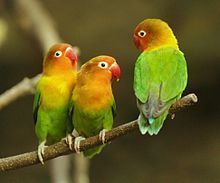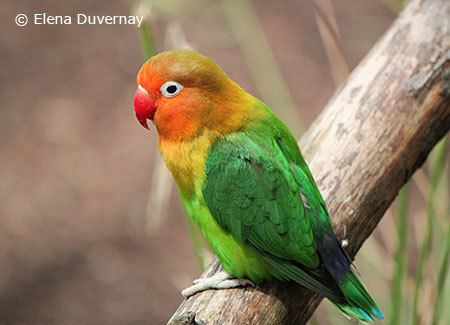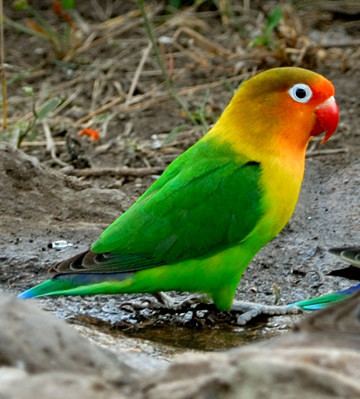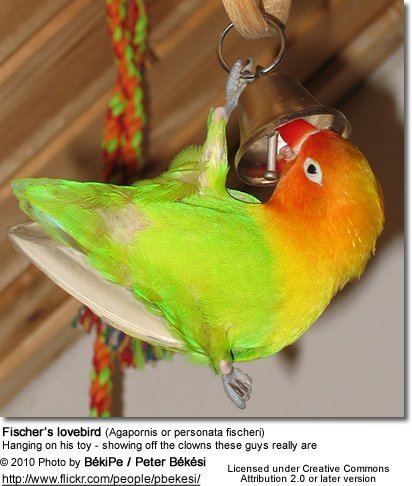Superfamily Psittacoidea Subfamily Agapornithinae Higher classification Lovebird | ||
 | ||
Similar Lovebird, Yellow‑collared lovebird, Bird, Rosy‑faced lovebird, Parrot | ||
Fischer s lovebird mating ritual
The Fischer's lovebird (Agapornis fischeri) is a small parrot species of the Agapornis genus. They were originally discovered in the late 19th century, and were first bred in the United States in 1926. They are named after German explorer Gustav Fischer.
Contents
- Fischer s lovebird mating ritual
- Talking parrot peepers the fischer s lovebird agapornis fischeri
- Description
- Sexual morphism
- Distribution and habitat
- Behaviour
- Food and feeding
- Breeding
- Aviculture
- Personality
- Health problems
- References

Talking parrot peepers the fischer s lovebird agapornis fischeri
Description

The Fischer's lovebird has a green back, chest, and wings. Their necks are a golden yellow and as it progresses upward it becomes darker orange. The top of the head is olive green, and the beak is bright red. The upper surface of the tail has some purple or blue feathers. It has a white circle of bare skin (eyering) around its eyes. Young birds are very similar to the adults, except for the fact that they are duller and the base of their mandible has brown markings. They are one of the smaller lovebirds, about 14 cm (5.5 in) in length and 43-58g weight.

While most Fischer's lovebirds are green, several color variations have been bred. The blue variation is predominant; lacking yellow, it has a bright blue back, tail, and chest, a white neck, a pale grey head and a pale pink beak. This mutation was first bred by R. Horsham in South Africa in 1957, and two years later it was bred by Dr. F. Warford in San Francisco, California. There is a yellow mutation, which first appeared in France. These birds are typically pale yellow with an orange face and a red beak. Lutino (a mutation that is yellow in color), pied, black or dark eyed white, cinnamon, white, and albino mutations have also been bred.
Sexual morphism

Fischer's lovebirds show no sexual dimorphism; therefore, it is impossible to tell whether an individual is male or female through plumage alone.

The sexes of Agapornis fischeri appear the same, and are distinguished with certainty through DNA testing, and less certainly by their habits in perching. Generally, females sit with their legs farther apart than males because the female pelvis is wider.
Distribution and habitat

Fischer's lovebird are native to a small area of east-central Africa, south and southeast of Lake Victoria in northern Tanzania. In drought years, some birds move west into Rwanda and Burundi seeking moister conditions. They live at elevations of 1,100-2,200m in small flocks. They live in isolated clumps of trees with grass plains between them. The population is estimated to be between 290,000-1,000,000, with low densities outside of protected areas due to capture for the pet trade; export licenses were suspended in 1992 to halt any further decline in the species.
Behaviour
Fischer's lovebird has a fast flight, and the sound of their wings as they fly can be heard. Like all Lovebirds, they are very vocal and when they do make noise they have a high-pitched chirp and can be very noisy.
Food and feeding
Fischer's lovebirds eat a wide variety of foods, including seeds and fruit. They sometimes are pests to farmers, as they eat their crops such as maize and millet.
Breeding
The breeding season is January through April and June through July. The nest is in a hole in a tree 2 to 15 metres above the ground. The eggs are white and there are usually four or five in a clutch, but there could be as few as three or as many as eight. The female incubates the eggs for 23 days, and the chicks fledge from the nest about 38–42 days after hatching.
Aviculture
Fischer's lovebirds are kept in captivity. Lovebirds are social animals and are popular as pets.
Personality
Lovebirds are seen as charming and affectionate by their owners. Though they're not as cuddly as many parrots, they enjoy spending time with their owners, and require regular interaction.
As with many parrots, lovebirds are intelligent and inquisitive birds. In captivity, they like to investigate around the house, and have been known to figure out ways to escape from their cages, and to find hiding places where they may get stuck, and where it may be difficult to locate them. In order to avoid escapes it is advised to lovebird owners to use a cage where the bird cannot get out simply by lifting or pushing the door with its beak.
Lovebirds are avid chewers, with strong beaks. They can enjoy "preening" the hair and clothing of their owners, and chewing on clothing, buttons, watches, and jewelry. They may also, especially the females, chew up paper and weave it into their tails, which they will carry back to their cages to make nests.
Female lovebirds are supposedly more aggressive than the males but both can make fine pets with patience and correct training.
Lovebirds (in general) are not known for their talking ability, although there are some lovebirds that do learn words - the females are usually the ones that do this. As is the case when many smaller parrots, the "voice" of lovebirds is high-pitched and raspy and it may be difficult to understand their speech.
Lovebirds are very vocal birds, making loud, high-pitched noises that can be a nuisance to neighbors. They make noise all day, but especially at certain times of day. However, Fischer's are not quite as loud as some other lovebird varieties, and while they cheep frequently, they do not scream like the larger parrots. Their noise level increases substantially when they are engaged in pre-mating rituals.
Health problems
Fischer's lovebirds, like many captive birds, can suffer from feather-plucking if they get bored or stressed. This is more likely to occur with single lovebirds than those kept in pairs or groups. They should have a roomy cage, and should be shown affection if they enjoy it. After feather-plucking starts, it is very hard to stop the habit. Providing them with plenty of toys and giving them more opportunities for entertainment will often reduce or stop the habit.
Fischer's lovebirds are prone to a mysterious disease characterized by having brownish to creamish patches in their feet and legs, which is probably an infection as a result of their obsessive biting of those areas. It is not known what causes this disease. One hypothesis is that they suffer from hormonal problems caused by changing light levels and the inability to perform things Fischer's lovebirds in the wild would naturally perform, such as building a nest. Another hypothesis is that it is caused by a pathogen. Treatments usually involve antibiotics for the wounds, and some way to stop them from continuing the biting of the area. This can sometimes be accomplished with sedatives. The Elizabeth collar may also be used, though wearing them is extremely stressful both to the bird wearing the collar and to the birds around it, and some lovebirds may start feather-plucking as a result of the stress.
Female lovebirds are prone to egg-binding, an often fatal condition in which an egg cannot be laid as it gets caught in the reproductive tract. It is thought that egg binding often occurs due to a lack of liquid calcium in the diet, which causes a softer shell. To prevent this, females, particularly those kept in pairs, should be given calcium supplementation in their water from a young age. Additionally, egg binding appears more likely amongst younger birds, and might be prevented by discouraging mating in younger birds.
